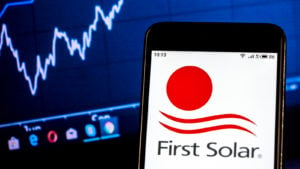Despite short-term headwinds, the solar energy industry has a number of long-term growth prospects to get excited about

Source: Fit Ztudio / Shutterstock
The renewable energy space has seen better days. The iShares Global Clean Energy ETF (NASDAQ:ICLN) is down about 23.9% over the past 12 months per trading data from Tuesday’s session. If we look even further back, say, over the past three years, the exchange-traded fund has suffered a dramatic 33.2% plummet in value. This contrasts with the sizable gains of 22.0% and 18.5% of the S&P 500 and the Nasdaq, respectively. The rise of interest rates and persistent inflation has put many renewable energy companies under duress. Many of these businesses are capital-intensive and require debt capital to build out their technologies.
Recent labor market and U.S. economic growth news have pointed to the possibility that high interest rates are doing their job. More economic data signaling that inflation is on its way out could incentivize the Federal Reserve to pursue rate cuts towards the end of the year, in turn rallying U.S. equities, especially renewable energy stocks.
Below are three renewable energy stocks sitting at attractive valuations.
First Solar (FSLR)

Source: IgorGolovniov / Shutterstock.com
First Solar (NASDAQ:FSLR) designs and manufactures photovoltaic solar modules. The company leverages thin-film semiconductor technology in its manufacturing to lower the carbon footprint of the production process.
In recent news, First Solar was able to surprise investors with a solid Q1 earnings report for fiscal year 2024. The company not only beat both revenue and earnings estimates sizably, but it also reiterated guidance for the full fiscal year.
First Solar shares have risen 9% over the past 12 months and 13% on a year-to-date basis. Obviously, when investing in a company like FSLR, rates are going to matter. Signals that rate cuts are likely will help pump energy into the company’s shares. These days, FSLR trades at 12.7x forward earnings, which is a nice multiple to have for a company operating in a new energy space.
NextEra Energy (NEE)

Source: madamF / Shutterstock.com
NextEra Energy (NYSE:NEE) is an integrated energy company that generates, transmits, distributes and sells electricity to customers across the United States. The company was once reliant on natural gas energy generation but in recent years has committed to cleaner alternatives, including wind and solar.
Similar to First Solar, investors found themselves quite pleased with NextEra’s first-quarter earnings results for 2024. While revenues decreased on a year-over-year (YOY) basis, adjusted earnings per share grew by 8% YOY. The company also placed 1,640 megawatts of solar energy into service, expanding on its already significant 6,400-megawatt solar portfolio. Moreover, NextEra added 2,765 megawatts of renewable energy origination to its backlog.
NextEra Energy’s share price has risen 19.5% year-to-date and trades at 21.4x forward earnings. Thus, its large renewable energy platform and not-so-expensive multiple places it in undervalued territory.
Canadian Solar (CSIQ)

Source: Shutter B Photo / Shutterstock.com
Canadian Solar (NASDAQ:CSIQ) makes the final entry on this list. The company builds and provides various solar energy and battery storage products. Canadian Solar also sells solar modules to not just residential customers but also industrial ones as well. Unfortunately, the stock has certainly taken a beating over the past few years. Over the past 12 months, CSIQ has fallen by nearly 53%. And over the past three years shares are down more than 55%.
The company’s relatively high debt coupled with elevated rates hasn’t sparked confidence from investors. Furthermore, consumer demand for new goods has dwindled due to rate hikes and persistent inflation.
However, better inflation news could help to catapult CSIQ to new heights. The company boasts the lowest valuation on this list, trading at only 5.7x forward earnings. The long-term tailwinds for Canadian Solar are there, and we just need the macro to start improving.
On the date of publication, Tyrik Torres did not have (either directly or indirectly) any positions in the securities mentioned in this article. The opinions expressed in this article are those of the writer, subject to the InvestorPlace.com Publishing Guidelines.

